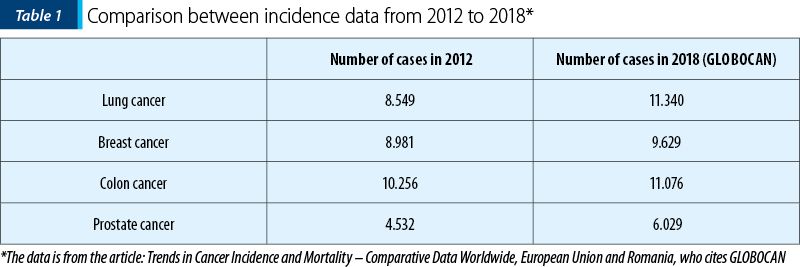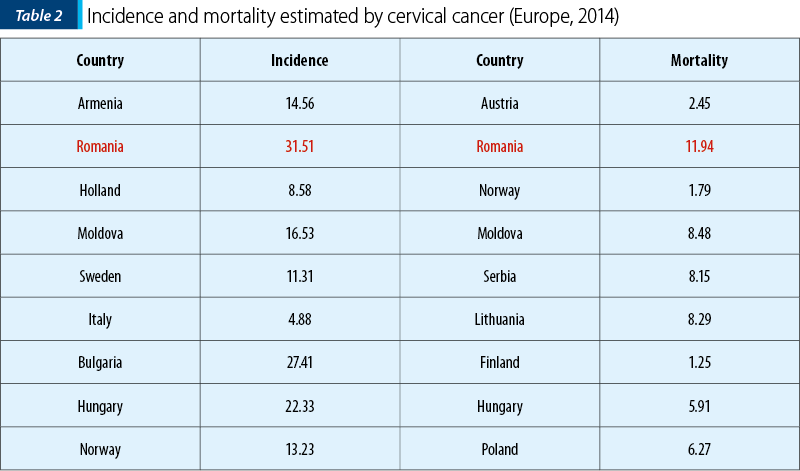Introduction
Before 1990, Romania had a national registry, but later it has been replaced by eight regional registries (2007); it has to be mentioned that they were only partially done and only in some centers. In these circumstances, beside some other necessary measures to achieve a stronger control of cancer, we appreciate that for Romania is more than useful to have a clear overview on the data regarding both the incidence and mortality by different forms of cancer at national level, based on the data coming from an analysis done by specialized institution of WHO: International Agency for Research on Cancer in Lyon, France, analysis that covered the period 2008-2012.
The comparison between incidence data from 2012 to 2018 reveals a steady increase in incidence (Table 1).

Reference: Nicolae-Dan Straja, Marieta Panait, Antonela Busca, and Sabin Cinca, “Prof. dr. Alex. Trestioreanu” Institute of Oncology, Bucharest, Romania, 252, Fundeni St., sector 2; E-mail: dr_danstraja@yahoo.com; sabincinca@yahoo.com, Proc. Rom. Acad., Series B, 2015 17(2), p. 125–136.
In 2012, the number of new cases of cancer in Romania was estimated at 78.760. In 2018, the estimated number of new cases is 83.461, so there is an increase in the overall incidence of cancer, although the population of Romania is steadily decreasing.
Reference: https://www.esmo.org/content/download/88489/1619945/file/Cancer-Background-Information-2016.pdf.
Pulmonary cancer
Pulmonary cancer remains the most common and with the highest mortality in the world. Regarding the incidence of pulmonary cancer, this has a steady increase in Romania, being a country with a high incidence of this type of cancer.
Global cancer observatory: https://gco.iarc.fr/today/data/factsheets/populations/642-romania-fact-sheets.pdf
Cervical cancer
In contrast to incidence trends, decreasing colorectal cancer mortality rates have been observed in a large number of countries worldwide and are most likely attributed to colorectal cancer screening, reduced prevalence of risk factors, and/or improved treatments. However, increases in mortality rates are still occurring in countries that have more limited resources and increasing incidence, including Brazil and Chile in South America and Romania and Russia in Eastern Europe.

References:
Bosetti C, Levi F, Rosato V, et al. Recent trends in colorectal cancer mortality in Europe. Int J Cancer. 2011; 129:180‐191.
Wiley Online Library CAS PubMed Web of Science®Google Scholar
Bosetti C, Bertuccio P, Malvezzi M, et al. Cancer mortality in Europe, 2005‐2009, and an overview of trends since 1980. Ann Oncol. 2013;24:2657‐2671.
Crossref CAS PubMed Web of Science® Google Scholar
Prostate cancer
Prostate cancer is the second most frequently diagnosed cancer in men worldwide, with 1.1 million new cases estimated to have occurred in 2012. It is the most frequently diagnosed cancer among men in more developed countries, where about two‐thirds of all prostate cancer cases occur among just 17% of the world’s male population. Incidence rates vary by more than 25‐fold worldwide, and are highest in Australia/New Zealand, Northern America, Northern and Western Europe, and some Caribbean nations, and lowest in Asia. Much of the variation reflects differences in the use of prostate‐specific antigen (PSA) testing. Prostate cancer is the fifth leading cause of cancer death worldwide, with the highest mortality rates found in the Caribbean and Southern and Middle Africa. The reason for the high prostate cancer risk among some populations of African descent is still poorly understood, although it may in part reflect differences in genetic susceptibility.
Female breast cancer
Breast cancer is the most frequently diagnosed cancer and the leading cause of cancer death among females worldwide, with an estimated 1.7 million cases and 521,900 deaths in 2012. Breast cancer alone accounts for 25% of all cancer cases and 15% of all cancer deaths among females. More developed countries account for about one‐half of all breast cancer cases and 38% of deaths. Rates are generally high in Northern America, Australia/New Zealand, and Northern and Western Europe; intermediate in Central and Eastern Europe, Latin America, and the Caribbean; and low in most of Africa and Asia. The international variation in breast cancer incidence rates reflects differences in the availability of early detection, as well as risk factors. Risk factors for breast cancer include reproductive and hormonal factors such as a long menstrual history, recent use of oral contraceptives, and never having children. Giving birth to children and breastfeeding decrease the risk of breast cancer.